Dragon 1/48 Fw-190A-7
Heinz Bär - Experte:
As an air‑minded working-class teenager, Heinz Bär took up the sport of gliding and soon became a qualified powered aircraft pilot at age of 17. With hopes of eventually flying for Deutsche Lufthansa, he joined the Luftwaffe in 1937, graduating from flight school in early 1939 with a promotion to Feldwebel for his performance as a student. The quality of prewar training would be evident throughout his wartime career.
Sent to JG 51, Feldwebel Bär scored his first victory - a French Hawk 75 over the Western Front - on September 25, 1939. Because he was flying Weiss 13 when he did this, Bär decided that 13 was his lucky number; almost all his later aircraft would carry this number whenever possible. When Werner Moelders was promoted to Geschwader Kommodore of JG 51 just before the beginning of the Battle of Britain, he chose Bär as his wingman. Bär went on to score ten victories during the Battle, and became a flight leader by the end of the year. JG 51 re-equipped with the Bf-109F during the Spring of 1941, and Bär continued to score regularly as the RAF began to “lean into France” with heavily-escorted daylight raids by a flight of Blenheims, which were attempts on the part of the RAF to draw the Jagdwaffe into combat.
JG 51 moved east to participate in Operation Barbarossa, and Bär scored spectacularly from the first day of the invasion. On July 2nd, 1941, with a score of 27, he was promoted from Feldwebel to Leutnant and awarded the Knight's Cross. By August 14th, his score stood at 60. He was promoted to Oberleutnant and awarded the Oak Leaves to the Knight's Cross, along with a promotion to Kommandeur of the new IV Gruppe of JG 51. On August 28, he was shot down 50 kilometers behind the Soviet lines. Despite a double fracture of his spine, he made it back to German territory.
Bär, now a Hauptmann with a score of 90, was awarded the Swords on February 16th, 1942. Shortly after, he was promoted to Major, and promoted to Geschwader Kommodore of JG 77, based in Sicily. He fought over North Africa with the unit, and also over Sicily and Italy, raising his score to 133 against both the RAF and USAAF, despite suffering from ulcers and malaria. He was evacuated back to Germany shortly after the Italian surrender in September 1943. Shortly thereafter he became Gruppenkommandeur of Jagd Gruppe “Sud” and managed to take part in several of the air battles over Western Europe in the Fall of 1943.
Bär participated in the “Revolt of the Kommodores” when Göring blamed the Jagdwaffe for failures against the Western Allies in Europe and the Mediterranean. His attitude of forthright honesty in an organization whose high command was so thoroughly corrupt earned him Goring's enmity. In December 1943, he was reduced to Staffelkapitaen with II./JG1 at Woensdrecht in Holland, the only Major in the Luftwaffe flying such an assignment. Oberstleutnant Walter Oesau, who had recently assumed command of JG 1 took him for his skills and to get him away from Göring's vengeance. Bär took the assignment gratefully and gave support to his inexperienced and lower-ranking Gruppenkommandeur. As the Eighth Air Force's daylight offensive grew in power in the early months of 1944, with JG 1 based directly in the path of the American missions, Bär became a “Fortress specialist.” As a master of the “Twelve O'Clock High” massed head-on attack against the bomber formations, flying the more heavily-armed Fw-190A-7, by mid-March 1944, he was credited with 14 B-17 and B-24 victories and was promoted to Gruppenkommandeur of II/JG 1.
Eventually, Bär shot down 21 B-17s and B-24s during his tour on the Western Front. On April 22, just after returning from an interception of heavies on their way to bomb Hamm, a lone B-24 was sighted northwest of the field at Stormede. Bär sprinted to his reserve Fw-190A-7 - Rot 23 - and took off with his wingman, Oberfeldwebel Leo Schumacher. After a 15-minute chase and battle, Bär scored his 200th victory - of which 59 were scored against the RAF and USAAF. Shortly thereafter, he was promoted Geschwader Kommodore of JG 3 in Germany, forcing Göring to recognize his ability.
That fall, Bär became involved with the development and flight testing of the Me-262. In the Spring of 1945, as Germany fell apart around him, Bär became the world's first triple-jet ace, shooting down 16 Allied aircraft in the closing weeks of the war. He was killed in May 1957 while performing an aerobatics routine for an air show in Frankfurt.
This model was originally built some 20 years ago, using the Verlinden set which provides full detail for the gun bays and weapons, and a nice resin engine section for a semi-open cowling. This is really about as much as an “opened up” Fw-190 model needs, since the BMW 801 was closely cowled; assembling individual parts such as cylinder heads and exhaust stacks would be difficult at best, an not likely to result in something as completely realistic as this plug.
Models do "age," and the original project had been done before the plethora of aftermarket decals for the Fw-190 was generally available. Given the price of the kit and the aftermarket set , not to mention the time spent originally on the work, a rebuild seemed a good idea. Removing the open covers and the canopy, the flaps, and taking the gear doors off the gear legs, the model was ready for stripping. I first used Easy Lift Off to break through the old varnish finish, then used Strip-A-Kit in repeated applications to take the model down to bare plastic, being careful to leave the gun bays, gear wells, and engine alone.
I had managed to score a copy of the Aeromaster Special decal sheet, “Luftwaffe Top Guns” which had the markings for Heinz Bär's “Red 23", the Fw-190A-7 in which he scored his 200th victory. A little research revealed the fact this was not a standard aircraft, since it was equipped with special broad-chord wooden propeller blades, and didn't carry the outboard cannons in order to save weight. Figuring that the prop blades were likely something from the Focke-Wulf factory and probably from the various experimental aircraft Kurt Tank was developing in early 1944 (there are no photographs I am aware of that show the prop for this airplane), I went looking through the spares box and found a set of blades for a Fw-190D-9, which hadn't been used. Armed with the propeller blades and the decals, I could proceed to do Bär's one-off special. The standard Fw-190A prop spinner was used with these blades, which fit with no difficulty.
By performing this restoration, a $25.00 model and a $30.00 aftermarket set were saved. Given that my painting skills are vastly different from what they were 20 years ago, the ultimate result is a far better-looking model than it was. I now have another very different-looking Fw-190 for the collection. If I ever lay hands on some 1/48 Luftwaffe ground crew, this would be a good candidate for a diorama.


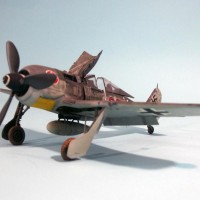
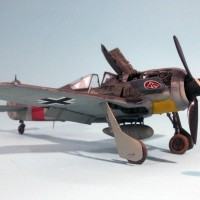
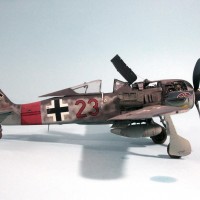
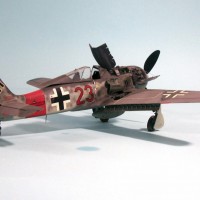

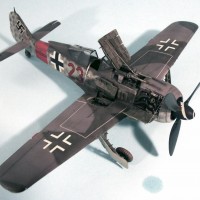
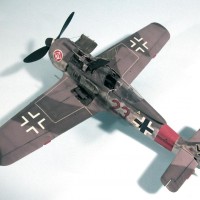
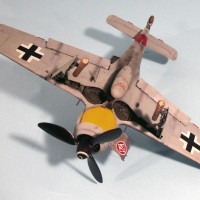
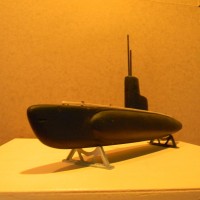
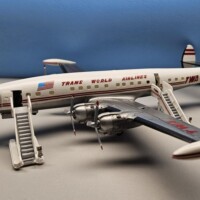
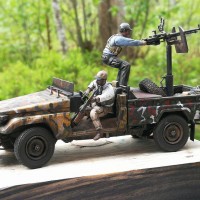
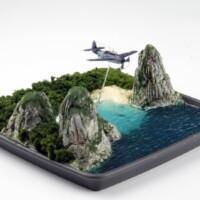
Beautiful 190! looks great and overall a real prize winner.!
Great story and a really nice restoration. It looks like it would press the pilot through the back of the seat if the throttle was opened up suddenly. Must be a totally different experience riding in one of those than in a Bf 109.
According to Steve Hinton, who's flown both the Fw-190A-5 and the Bf-109E that Paul Allen has, there's never a thought of ground-looping on takeoff with the Fw-190, which is a likelihood with the 109 unless the pilot is about "10 feet ahead of the airplane" as he put it when I asked.
GREAT looking build, TC...one of your better efforts IMO.
Very nice model Tom. Interesting reading about how you “reset” the kit to a new fresh paint coat. I still have this model built (to pieces) somewhere, but find the stripping of paint a fearful experience, even more with all that AM stuff added. Oh, and thanks about the propeller hint. I also have that same aeromaster decal sheet so it is a very helpful information
Stripping isn't as bad as people think. I've done it frequently. I use Floquil "Easy Lift Off" (ELO) which is available at train stores if you don't have a well-equipped LHS around. Take off the bits that can be broken off, then apply a single coat. Let it sit about 15-20 minutes (no longer! It will "eat" plastic if you leave it on!) and then rub it off; I use teflon pads, since they don't scratch. Wash it off, then re-apply as necessary (usually the first coat will break through the varnish). Keep re-applying to the areas where paint adheres (under decals is always going to happen) until it's all off. Then wash in soapy water to get the residue off. Let it air dry and you have a model ready to paint.
Very nice, Tom. You did a very beautiful job on Rot 23. I used the oooold monogram kit for my build; and as you said, it was more of an A-3/5 than and A-7. I really love that paint job and the story of Bär's 200th kill. The crew of the B-24, "Flak Magnet", had already bailed out and the bomber was flying on autopilot. Bär didn't know it was unoccupied...a kill is a kill.
Very nice !
Good story and do-over Tom. I've stripped and repainted 5 aircraft the hard way. Nail polish remover and paper towel...1" at a time.
Read my description of the easy way above, George.
Thanks Tom. I can't find any in Canada, about $30USD+ is the cheapest I have found online so far. The closest LHS, if you can call it that is a 4hr. round trip. I did see an acrylic paint remover listed in Walmart but again, 4hr. trip with no guarantees that they carry it
Great save, Tom!
Nice Tom! I would have loved to see a few "before" pics for comparison!